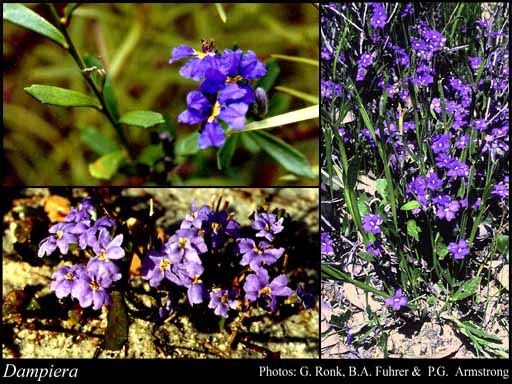- Reference
- Prodr.Fl.Nov.Holland. 587 (1810)
- Name Status
- Current

Scientific Description
Common name. Dampieras. Family Goodeniaceae.
Habit and leaf form. Shrubs (subshrub), or herbs. ‘Normal’ plants, or switch-plants; often with the principal photosynthesizing function transferred to stems. Leaves well developed, or much reduced, or absent. Perennial. Leaves cauline. Stem internodes solid. Mesophytic, or xerophytic. Leaves alternate; spiral; petiolate to sessile; non-sheathing; simple; epulvinate. Leaf blades entire; flat, or solid; sometimes terete, or semi-terete; linear, or ovate, or oblong, or trullate; pinnately veined. Leaves without stipules. Leaf blade margins entire (or sinuate), or dentate (obtusely). Leaves without a persistent basal meristem. Leaf anatomy. Hairs present, or absent; complex hairs present, or absent. Complex hairs sometimes stellate (or dendritic or centrifixed, cottony or woolly). Extra-floral nectaries absent (ass.). Stem anatomy. Secondary thickening absent, or developing from a conventional cambial ring.
Reproductive type, pollination. Fertile flowers hermaphrodite. Unisexual flowers absent. Plants hermaphrodite. Entomophilous. Pollination mechanism conspicuously specialized (involving a stylar modification for pollen presentation).
Inflorescence and flower features. Flowers solitary, or aggregated in ‘inflorescences’; terminal, or axillary; in racemes, or in spikes (or spike-like), or in heads, or in umbels, or in panicles (irregular cymo-panicles), or in cymes (in a thyrse). The terminal inflorescence unit cymose, or racemose. Inflorescences scapiflorous, or not scapiflorous; terminal, or axillary; with involucral bracts, or without involucral bracts; pseudanthial, or not pseudanthial. Flowers pedicellate, or subsessile; bracteate (opposite); bracteolate (sometimes), or ebracteolate; small to medium-sized; very irregular. The floral asymmetry involving the perianth and involving the androecium. Flowers 5 merous; cyclic; tetracyclic. Free hypanthium absent. Perianth with distinct calyx and corolla; (8–)10; 2 -whorled; isomerous, or anisomerous. Calyx present; 5 (or obsolete); 1 -whorled; polysepalous, or gamosepalous; blunt-lobed (ass.); tubular. Corolla present; 5; 1 -whorled; appendiculate (the upper lobes auriculate); gamopetalous; lobed. Corolla tube adaxially deeply split. Corolla valvate; bilabiate; white (rarely), or yellow, or red, or pink, or purple, or blue (with yellow throat). Androecial members definite in number. Androecium 5. Androecial members free of the perianth, or adnate; all equal (ass.); coherent; 1 -whorled. Androecium exclusively of fertile stamens. Stamens 5. Staminal insertion near the base of the corolla tube. Stamens all more or less similar in shape (ass.); isomerous with the perianth; oppositisepalous (at the base of the corolla); all alternating with the corolla members. Anthers cohering; basifixed; dehiscing via longitudinal slits; introrse; tetrasporangiate. Pollen shed in aggregates, or shed as single grains. Gynoecium 2 carpelled. The pistil 1–2 celled. Gynoecium syncarpous; synstylovarious to eu-syncarpous; inferior. Ovary unilocular, or plurilocular; 1–2 locular. Gynoecium stylate. Styles 1; bearing an ‘indusium’ beneath the stigma. Indusium cupular, or two-lipped, or globular. Styles apical. Stigmas 1; 2 - lobed. Placentation axile. Ovules in the single cavity 1; 1 per locule; ascending; non-arillate; anatropous.
Fruit and seed features. Fruit fleshy, or non-fleshy; indehiscent; a drupe, or a nut; 1 celled (per locule). Seeds copiously endospermic. Endosperm oily. Seeds winged, or wingless. Cotyledons 2. Embryo straight.
Special features. The upper lip of the corolla incorporating 2 members, the lower 3; (posterior, adaxial) lip of the corolla bilobed. Lower (abaxial) lip of the corolla 3 lobed.
Etymology. After William Dampier (1652–1715), English navigator; visited the northwest coast of Western Australia in 1688 and 1699; named Rosemary Island, off the present town of Dampier, on account of a bush, probably Olearia axillaris, which reminded him of English rosemary. Collected some 17 plants in Western Australia which were the first Australian plants to reach European herbaria; about a dozen are still preserved in the Oxford herbarium.
Taxonomic Literature
- Wheeler, Judy; Marchant, Neville; Lewington, Margaret; Graham, Lorraine 2002. Flora of the south west, Bunbury, Augusta, Denmark. Volume 2, dicotyledons. Australian Biological Resources Study.. Canberra..
- Australian Biological Resources Study 1992. Flora of Australia. Volume 35, Brunoniaceae, Goodeniaceae. Australian Govt. Pub. Service.. Canberra..
- Rajput, M. T. M.; Carolin, R. C. 1988. The genus Dampiera (Goodeniaceae) : systematic arrangement, nomenclatural notes and new taxa.